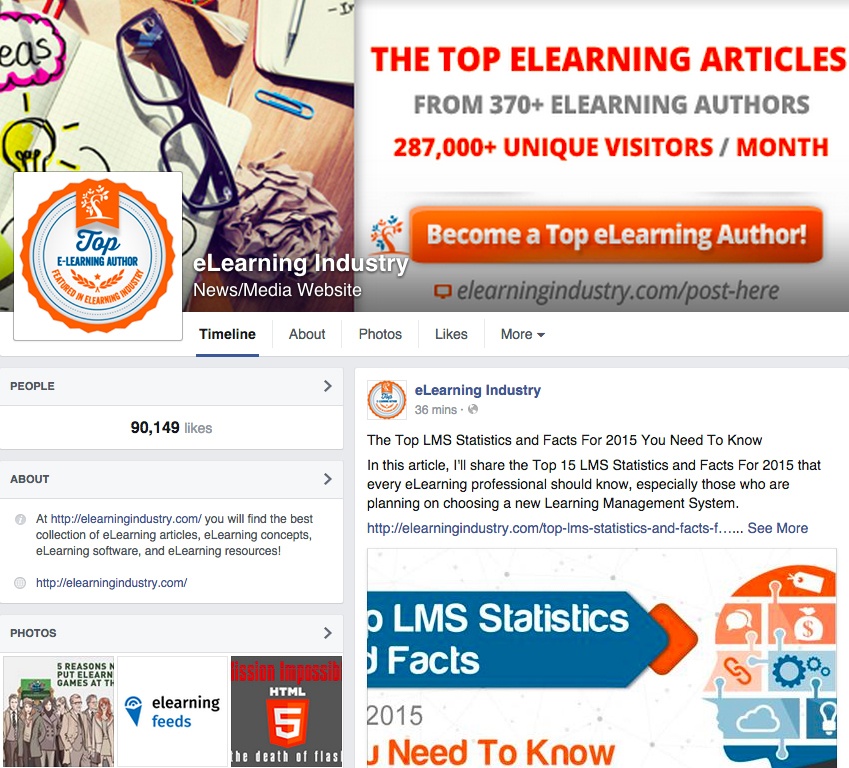How To Use Facebook For eLearning: What eLearning Professionals Should Know
Facebook is an increasingly popular social networking site that helps us keep in touch with friends and stay up-to-date with the latest news and events. While Facebook was not created as an educational tool, creating eLearning groups, sharing eLearning content and participating in eLearning course-related online discussions on Facebook, have been proven effective strategies for a large number of eLearning professionals. If you are not one of the 90,000 eLearning professionals who follow eLearning Industry on Facebook to keep up with what we’re doing, working on, and seeing great sources focused on eLearning, you are more than welcome to do so!
The nature of this social network enables the enhancement and support of eLearning, as it makes it particularly easy for your audience not only to connect and build relationships with their virtual classmates, but also to exchange eLearning information. In this article, I'll present the advantages and the disadvantages of integrating Facebook into your eLearning strategy, in order to determine whether it will work for you. I will also give you 9 tips on how to use Facebook for eLearning purposes.
Using Facebook For eLearning: Strong Points
- It is accessible to everyone.
Facebook is a tool that almost everyone is familiar with. At the same time, it can be easily accessed anytime, anywhere. By safely assuming that the vast majority of your learners or employees are already using Facebook, sharing knowledge becomes particularly easy and efficient without having to search for another platform for their learning. - It is ideal for social learning.
There is a variety of ways to use Facebook for social learning, because by nature it encourages open communication, information sharing, and networking. When using Facebook as an eLearning platform, your learners are allowed to discuss ideas, ask questions, share experiences, and discover new information. Given that social interaction positively impacts the way that people learn and work, Facebook is the ideal platform to boost collaboration and active learning. - It enhances learner engagement.
Because Facebook is so popular and user-friendly it makes it easier for the more restrained members of your audience to motivate and express their ideas and concerns. Social learning platforms foster online discussion, and even passive learners, get motivated to participate in eLearning debates by asking questions or by making comments and suggestions. - It is inexpensive.
Last but not least, Facebook is probably the most cost-efficient way to share eLearning content with your audience. Imagine it as a default Learning Management System with pre-defined structure and navigation; the only thing you need to do is to decide how you want to organize and distribute your online course.
Using Facebook For eLearning: Weak Points
- It is distracting.
You are probably a Facebook user yourself, so you know how it works; you login to “just quickly check something” and, before you realize it, you have already spent two hours browsing pictures, watching videos, and reading posts on a variety of topics. Facebook empowers one of your worst enemies: learner procrastination. It is the ultimate temptation for your audience to wander around, thus it makes the learning process less effective compared to a more structured and formal learning environment that would probably better enhance knowledge retention. - It is not secure.
The difference between your Learning Management System and Facebook is that the latter opens up the possibility for fraud and virus attacks. There are many cases where Facebook users have fallen prey to the lure of seemingly legitimate and genuine online scams, resulting in information or identity theft. You certainly don’t want your learners to be the victims of fraud in your eLearning environment. - It limits the control you may have over eLearning content.
The uninhibited exchange among your learners makes it difficult to determine not only the exact type of information that actually reaches them, but also if this information is in synch with your eLearning content, objectives, and goals. Surely, knowledge is supposed to be as wide as possible; however, Facebook’s open nature may sometimes lead learners to confusion due to lack of specific structure in the presentation of your eLearning content. - It cannot provide feedback on performance.
Feedback is essential throughout the eLearning process, as it is critical for your eLearning course evaluation. Unlike many Learning Management Systems, Facebook cannot provide you neither with information about your audience’s progress nor about employees’ learning path. This is a major limitation as it makes it harder for you to draw conclusions on the effectiveness of your eLearning activities.
9 Tips On How To Use Facebook For eLearning
Despite the disadvantages, there are a variety of ways to effectively incorporate Facebook in your eLearning course strategy in order to enhance the eLearning course experience of your learners. Below I share 9 useful tips to follow:
- Use Facebook to create a strong sense of community among your learners.
Your learners, being humans, are social creatures; whether you use Facebook as an eLearning platform or not, you must admit that the colossal success of social media in general shows once more that people enjoy interacting with each other. Building a strong community among your audience opens up a wide range of opportunities for learner engagement. - Encourage peer-to-peer discussion via Facebook Groups.
One of the most convincing arguments for using Facebook for eLearning is that it boosts online collaboration. For example, if you are offering an asynchronous eLearning course where learners have very little, if any, interaction with their peers, Facebook can give you the opportunity to integrate peer-to-peer discussion into your eLearning course. Facebook groups can be used to spark discussions, share feedback on ideas or assignments, and even to work collaboratively to complete a class project. The possibilities are endless when it comes to informal learning on Facebook, especially for those who are thirsty for knowledge and want to broaden their understanding of the subject matter that is being covered in the eLearning course. Encourage collaboration and information sharing in your virtual classroom and motivate your learners to help others and ask for help as often as possible. Show them that they have much to learn not only from you and your eLearning course, but also from each other. - Use Facebook messages to reach out to your audience.
Facebook gives you the option to use its messaging system to stay in touch not only with learners and with other eLearning professionals too. In this sense, Facebook serves as a great support tool. If your learners have a question, they can check to see if you’re online and get in contact with you immediately. Rather than waiting for an email response, they can have their answers within a matter of minutes, and address any concerns that may be preventing them from fully participating in the learning process. - Break your eLearning content into short and simple Facebook posts.
Facebook studies have revealed that short posts gain much more likes, comments, and shares than long ones. Keeping also in mind that the average learner attention span is generally short, you might benefit from this data and follow a more “bite-sized” formula for your posts. When you provide your audience with a series of small pieces or sections of eLearning information, it is easier for them to pay attention and retain knowledge. Just remember that being short is not enough; in order for your eLearning content to be fully absorbed, it must also be meaningful and engaging. - Create a group and post supplement resources for your audience.
For learners who may be particularly interested in a topic, as well as for those who may be struggling to understand key concepts, you can post additional learning resources on the Facebook wall or create a closed group to meet the needs of these learners. You can even post assignments that learners can complete to earn extra credit, or links to videos and articles that they may find helpful. Facebook is a powerful networking tool ideal for eLearning professionals who want to reach out to their audience and provide them with extra resources and tools they need to succeed. - Ask learners to carry out research on Facebook.
Rather than using traditional research sites, like Wikipedia, you can ask your learners to research a topic exclusively on Facebook. They can do this by reaching out professionals in the field, as well as looking up Facebook groups who may have more insight into a particular subject matter. This not only expands their comprehension of the topic itself, but also allows them to develop their research and technology skills. They can learn how to search for key terms to find the information they need, as well as how to communicate with others in an online environment, which is becoming increasingly important to today’s tech-centric world. - Get invaluable feedback for your eLearning course by using Facebook polls.
Pinpointing weak spots in your eLearning course and gauging learner satisfaction is easy with Facebook polls. You can create a poll by developing a list of simple questions that can be posted on your wall. Learners then have the opportunity to give you feedback, which you can use to improve their eLearning experience and identify how you can make your eLearning course even more effective and memorable for future learners. - Use Facebook to send reminders and notifications of upcoming deadlines and assessments.
There are a variety of ways that you can keep your audience updated about upcoming events. You can post on your wall reminders of approaching assessments or assignment deadlines or even use the Facebook events section to let learners know about live classroom sessions or webinars that they may want to attend, particularly those that advanced sign-up is needed. This motivates learners by keeping them focused on projects, and keeps busy learners organized and on-track to successfully completing the eLearning course. You can also use the events sections and reminder posts to inform your audience about new eLearning courses that may be of interest to them, so that they can benefit from any additional eLearning experiences that you are offering in the future. - Focus on visuals.
Finally, it is obvious that photos and videos are shared and liked much more than text in Facebook, which means that people are more attracted to visual content. Carefully chosen images, animations, graphics, and videos grab your audience’ attention and drive their engagement, as they make it easier for them to focus. Of course, you should not bombard your audience with visual elements; being creative and careful with your text-image balance will both please your learners and effectively support your eLearning objectives and goals.
Facebook is free to use, accessed by millions of users every day, and easy to use, which makes it the ideal tool for eLearning professionals. With Facebook, you can design eLearning experiences that are engaging, interactive, and collaborative for your audience.
Now that you know how to evaluate the use of Facebook for eLearning you may be interested in reaching your audience via another social medium: Twitter. Read the article Using Twitter For eLearning: 8 Pros And 6 Cons To Consider and find out important factors to consider if you want to incorporate Twitter into your eLearning strategy.







